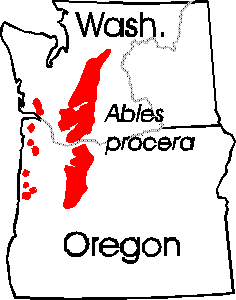
Drawing of the largest known noble fir, on Yellowjacket Creek [Robert Van Pelt] (2).
Common Names
Noble or red fir, larch (4).Taxonomic notes
Syn: Abies nobilis (Douglas ex D. Don) Lindley 1833, not A. Dietrich 1824 (1). Extensively hybridizes with A. concolor in southern Oregon and with A. magnifica in northern California; see discussion under Abies magnifica . Abies grandis also hybridizes with A. concolor in southern Oregon, making it quite a problematic area for field identification of firs.Description
Trees to 80 m tall and 220 cm dbh; "crown spirelike. Bark grayish brown, in age becoming thick and deeply furrowed (furrows and ridges about same width) and reddish brown (especially reddish when plates flake off). Branches diverging from trunk at right angles, stiff; twigs reddish brown, finely pubescent for several years. Buds hidden by leaves, tan, ovoid, small, not resinous, apex rounded; basal scales short, broad, equilaterally triangular, pubescent centrally, not resinous, margins entire to crenate, apex sharp-pointed. Leaves 1-3(3.5) cm × 1.5-2 mm, 1-ranked, flexible, proximal portion often appressed to twig for 2-3 mm (best seen on abaxial surface of twig), distal portion divergent; cross section flat, with prominent raised midrib abaxially, with or without groove adaxially, or cross section 4-sided on fertile branches; odor pungent, faintly turpentinelike; abaxial surface with 2-4 glaucous bands, each band with (4)6-7 stomatal rows; adaxial surface bluish green, with 0-2 glaucous bands, each band with 0-7 stomatal rows at midleaf; apex rounded to notched; leaves on fertile branches 4-sided with 4 bands of stomates below; resin canals small, near margins and abaxial epidermal layer. Pollen cones at pollination ± purple, ± red, or reddish brown. Seed cones oblong-cylindric, 10-15 × 5-6.5 cm, green, red, or purple, overlaid with green bracts, at maturity brown (bracts light-colored and scales dark), sessile, apex rounded; scales ca. 2.5 × 3 cm, pubescent; bracts exserted and reflexed over scales. Seeds 12 × 6 mm, body reddish brown; wing slightly longer than body, light brown to straw; cotyledons (4)5-6(7). 2 n =24" (1).Range
USA: Washington, Oregon and California at 60-2700 m elevation in mixed conifer forests (1). See also (6).Big Tree
Largest: Height 72.6 m, dbh 275 cm, crown spread 12.5 m, stem volume 174.3 m 3 in 1988; along Yellowjacket Creek in Gifford Pinchot National Forest, WA (2).Tallest: Height 89.9 m, dbh 192 cm, crown spread 13 m, stem volume 87.7 m 3 in 1989; in Goat Marsh Research Natural Area, Mt. St. Helens National Monument, WA (2).
Oldest
The ITRDB tree-ring chronology WA028 covers 1655-1976, 321 years, and is probably derived from live-tree material. Burns and Honkala (3) report ages of >300yrs without supporting data.Dendrochronology
There is the above-mentioned tree-ring chronology. The species has seen limited use. Applications have included stable isotope analysis to infer climate variation, single-year calibration of the radiocarbon time scale, forest structural change in response to windthrow, and forest decline due to volcanic ash deposition (5).Ethnobotany
The wood was formerly used for airplanes and ladders, in both cases because it is light, strong and can be bent far before breaking. It is still regarded as one of the best true firs for lumber due to the strength of the clear, lightly grained wood.Observations
The Goat Marsh RNA stand, mentioned above, is well worth a visit. Some fine stands can be found in Mount Rainier National Park.Remarks
This species is aptly named, for it is probably the largest of all Abies in terms of diameter, height and wood volume. It was first found by fabled botanist-explorer David Douglas, growing in mountains on the north side of the Columbia River Gorge, where exceptional stands can still be found. It loves these windy sites because it is one of the most windfirm trees, swaying grandly in even the most howling gales of winter.Citations
(1) Richard S. Hunt at the Flora of North America web site .(2) Van Pelt 1996 .
(3) Burns & Honkala 1990 .
(4) Peattie 1950 .
(5) Search the Bibliography of Dendrochronology .
(6) Robert S. Thompson, Katherine H. Anderson and Patrick J. Bartlein. 1999. Atlas of Relations Between Climatic Parameters and Distributions of Important Trees and Shrubs in North America. U.S. Geological Survey Professional Paper 1650 A&B. URL= http://greenwood.cr.usgs.gov/pub/ppapers/p1650-a/pages/conifers.html , accessed 22-Jan-2000.
See also:
FEIS database
.
Liu 1971
.
Maze & Parker 1983
.
Vidakovic 1991
.
[ Abies ] [ Pinaceae ] [ home ]
This page is from the Gymnosperm Database
URL: http://www.geocities.com/RainForest/Canopy/2285/pi/ab/procera.htm
Edited by Christopher J. Earle
E-mail:
earlecj@earthlink.com
Last modified on 22-Jan-2000
